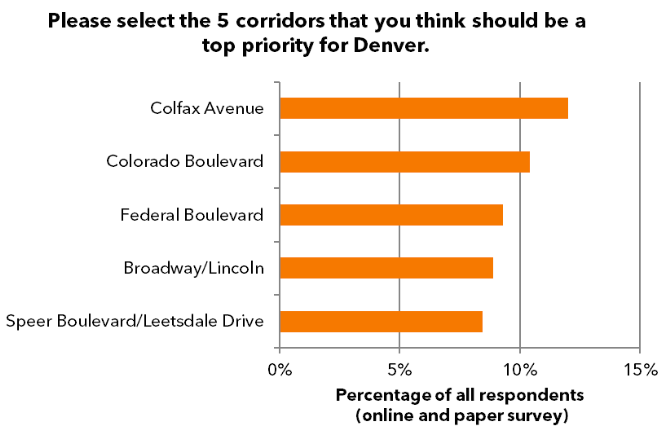Survey Says: These Five Corridors Are Denverites’ Top Priority for Better Transit

The Hancock administration has identified 19 corridors where Denver transit should be beefed up with more frequent service, faster travel speeds, and safer walking conditions. All of those streets make sense for transit improvements because ridership is already high or is projected to grow with future development. But where should Denver start as it sets out to make a grid of high-quality transit throughout the city?
Last week planners released the results of a survey that identified the five corridors Denverites think are most in need of better transit: Colfax Avenue, Colorado Boulevard, Federal Boulevard, the Broadway/Lincoln corridor, and the Speer/Leetsdale corridor. About 1,000 people filled out the survey, which was conducted over six weeks this summer, mostly online.
That doesn’t mean the other 14 corridors will get left behind. City Hall wants to increase service on all of them as part of a high-frequency grid connecting all parts of Denver proper. But the survey results will inform where the city initially focuses capital improvements like transit-only lanes, traffic signals that prioritize buses, and better bus stops.
“When we think about evaluating [these streets] for transit capital improvements, what we mean is that there will be a subset of these corridors that are going to be ripe for higher capacity transit — whether that’s bus rapid transit or rail,” said Jennifer Wieland, a principal at Nelson\Nygaard, which is consulting on the Denveright transit plan. “The vast majority of them, though, we will probably recommend as priority bus corridors. So corridors where we’re really enhancing speed and reliability.”

On some of these streets, public agencies have already started the process of upgrading transit and walking infrastructure. East Colfax (though not West Colfax) is slated for a bus rapid transit line. Broadway and Lincoln just got 24/7 bus lanes. And the city had previously identified Federal and the Speer/Leetsdale corridor as candidates for transit priority treatments.
As the Denveright planning process zeroes in on a course of action, the question of how to pay for more and better transit service looms larger.
“Ultimately delivering that frequent network costs a lot of money,” said Thomas Brennan, also a Nelson\Nygaard principal. “Service is very expensive, and that’s the money that’s raised through local taxes. So there will be upcoming challenges to deliver that revolve around raising the money to pay for it.”
Mayor Hancock and City Council President Albus Brooks have alluded to creating a permanent funding stream for sustainable transport. How they plan to do that remains a great unknown.
In Los Angeles and Seattle, public officials put special transportation taxes to a vote. In both cities, voters have recently signed off on ballot initiatives to raise tens of billions of dollars for transit.
The price tag for Denver’s intra-city transit improvements should become clearer soon. The task force responsible for guiding the plan, which includes City Councilwoman Robin Kniech, will start tackling costs, funding, and implementation at its December 7 meeting. The full draft of Denver’s first-ever transit plan is due out in early 2018.


